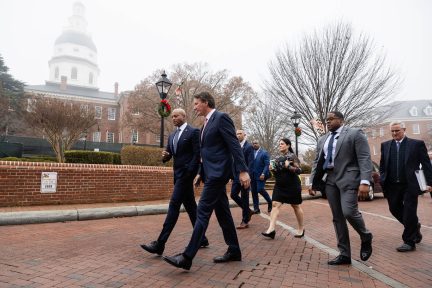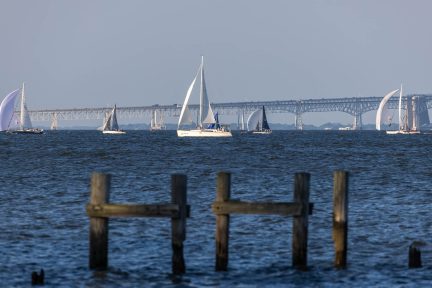Chesapeake Bay Program reports overall decline in nitrogen, sediment pollution reaching the Bay
Chesapeake Bay Program reports overall decline in nitrogen, sediment pollution reaching the Bay
Today, the Chesapeake Bay Program announced that the amount of nitrogen and sediment pollution entering the Chesapeake Bay continued to decrease, while phosphorus pollution slightly increased from the previous assessment period. Each year, the seven watershed jurisdictions--Delaware, Maryland, New York, Pennsylvania, Virginia, West Virginia and the District of Columbia--report the practices they have implemented to decrease the amount of pollution entering the Chesapeake Bay.
The modeling team at the Chesapeake Bay Program runs this information through a sophisticated suite of modeling tools that generate estimates of how far our partners have come toward meeting their individual pollutant reduction goals as outlined in the Chesapeake Bay Total Maximum Daily Load (Bay TMDL).
According to the Chesapeake Bay Watershed Model, pollution controls put in place between 2009 and 2019 are estimated to have lowered overall nitrogen loads 11%, phosphorus loads 10% and sediment loads 4%. Experts attribute the decreases in estimated nitrogen and phosphorus loads to upgrades to wastewater treatment facilities, while reductions in sediment loads are due primarily to the implementation of best management practices in the agricultural sector.
Through the Chesapeake Bay Watershed Agreement, the Chesapeake Bay Program has committed to having in place 100% of the practices that would achieve all of the nitrogen, phosphorus and sediment reductions necessary to meet the goals outlined in the Bay TMDL in place by 2025. As of 2019, practices are currently in place to achieve 39% of the Bay TMDL nitrogen reductions, 49% of the Bay TMDL phosphorus reductions and 100% of the Bay TMDL sediment reductions.
To learn more about our progress toward having practices and controls in place to achieve a healthy Bay by 2025, visit ChesapeakeProgress.com.
Facts
These estimates are generated by the Chesapeake Bay Watershed Model and are derived from land use data, implementation and effectiveness of best management practices and the most up-to-date water quality monitoring data. In January 2016, the Chesapeake Bay Program Management Board decided that the Watershed Model would be updated every two years to account for the most up-to-date science, data and information available to inform our partners’ shared restoration efforts and collective decision-making processes. This also meant that any updates identified during the two-year period would be held and applied to the Watershed Model at the same time, after the two-year period expired. Updating the Watershed Model on a consistent two-year basis provides a holistic view of how our management actions and decisions are impacting water quality and living resources across the watershed. These updates have the potential to change the amount of pollution estimated to enter the Bay from the rest of the watershed, but are critical to our understanding of the most accurate representation of changes that have occurred over the previous two years or more for a given geographic area. For more information on how the Watershed Model is updated, take a look at Understanding Chesapeake Bay Modeling Tools: A history of governance, policy and procedures.
The Environmental Protection Agency (EPA) uses these estimates to evaluate whether jurisdictions are on track to meet the Bay TMDL reduction goals and their associated two-year milestone commitments. The EPA released its evaluations of the 2018-2019 final progress reports and 2020-2021 two-year milestones in July 2020.
Computer simulations show that between 2009—the Bay TMDL baseline—and 2019:
- Overall nitrogen decreased 11%, from 297.9 million pounds in 2009 to 265.3 million pounds in 2019, meeting 39% of the goal to reduce nitrogen by 2025.
- Overall phosphorus decreased 10%, from 17.1 million pounds in 2009 to 15.3 million pounds in 2019, meeting 49% of the goal to reduce phosphorus by 2025.
- Overall sediment decreased 4%, from 18.9 billion pounds in 2009 to 18.1 billion pounds in 2019, meeting 100% of the goal to reduce sediment by 2025.
Computer simulations show the following jurisdiction-specific breakdown of overall pollution reductions between 2009 and 2019:
- In Delaware, pollution controls have lowered nitrogen loads 11%, phosphorus loads 19% and sediment loads 42%. The state fell short of its 2019 pollution reducing target for nitrogen but met its targets for phosphorus and sediment.
- In the District of Columbia, pollution controls have lowered nitrogen loads 26%, phosphorus loads 11% and sediment loads 19%. The District has met each of its 2019 pollution reducing targets.
- In Maryland, pollution controls have lowered nitrogen loads 12%, phosphorus loads 2% and sediment loads 0%. The state fell short of its 2019 pollution reducing targets for nitrogen and phosphorus but met its target for sediment.[1]
- In New York, pollution controls have lowered nitrogen loads 6%, phosphorus loads 15% and sediment loads 7%. The state fell short of its 2019 pollution reducing targets for nitrogen and sediment but met its target for phosphorus.
- In Pennsylvania, pollution controls have lowered nitrogen loads 4%, phosphorus loads 15% and sediment loads 14%. The Commonwealth has fallen short of each of its 2019 pollution reducing targets.
- In Virginia, pollution controls have lowered nitrogen loads 14% percent, phosphorus loads 10% and sediment loads 2%. The Commonwealth fell short of its 2019 pollution reducing targets for nitrogen and phosphorus but met its target for sediment.[2]
- In West Virginia, pollution controls have lowered nitrogen loads 4%, phosphorus loads 31% and sediment loads 8%. The state has met each of its 2019 pollution reducing targets.
[1] Although the phosphorus loading results from 2019 progress are significantly higher than in past years, Maryland has explained that this is due to unusually wet weather and known data errors that will be corrected in future reporting years. Maryland anticipates that the 2019 progress was an outlier for phosphorus and that Maryland’s phosphorus loads will be closer to achieving the Phase III WIP planning targets in 2020 progress.
[2] The data submitted by Virginia for 2019 progress were incomplete, missing approximately 44,000 BMP records. As a result, the 2018-2019 simulations are not indicative of Virginia’s actual 2019 progress. These data transmission errors have been corrected for the release of the new version of model, CAST 2019, which will be used for evaluations of 2020-2021 milestone goals.
Issues
Excess nitrogen, phosphorus and sediment are among the leading causes of the Bay’s poor health. Nitrogen and phosphorus can fuel the growth of algae blooms that lead to low-oxygen “dead zones” that suffocate marine life. Sediment can block sunlight from reaching underwater grasses and suffocate and bury shellfish.
Pollution reducing practices used in backyards, in cities and on farms can reduce the flow of nitrogen, phosphorus and sediment into waterways. Management actions taken to decrease pollution from point sources (e.g. wastewater treatment plants) may immediately show detectable changes, but in regard to the implementation of conservation practices for non-point sources (e.g. runoff that may include excess fertilizer or toxics), there is often a lag in measuring their impact on improving water quality and the health of the Bay.
Importance
By incorporating the best available data into our computer simulations and pollution load estimates, the Chesapeake Bay Program can more accurately track our partners’ progress toward their pollution-reducing goals. These data give state agencies and local leaders the science-based information they need to assess their pollution reducing practices and adapt their management decisions as needed.
Tracking the progress that each jurisdiction is making toward reducing nitrogen, phosphorus and sediment pollution entering not only the Chesapeake Bay, but also their local waterways, is helping to improve overall water quality, restore habitats and increase the populations of many plant and animal species. A more accurate picture of pollution in the watershed provides an overall more accurate understanding of the actions that are needed to restore water quality in our work toward an environmentally and economically sustainable Chesapeake Bay watershed.
Quotes
"For many years, jurisdictions in the Bay watershed have and continue to undertake substantial efforts to control and mitigate pollution in the Chesapeake Bay. These efforts include plans and on-the-ground practices to reduce pollution to meet water quality goals by 2025. Bringing the best available science to the table, in addition to learning from each jurisdiction’s experiences is critical to achieving pollutant reduction targets and collectively attaining our water quality goals."
- Ed Dunne, Co-Chair of the Water Quality Goal Implementation Team and Chief, Standards and TMDL Branch, Water Quality Division, Department of Energy and Environment, District of Columbia
“Local jurisdictions and their residents can be proud of the water quality improvements to the Bay and its tributaries. We should celebrate those successes but remember that wastewater upgrades and stormwater improvements are expensive to build, operate, and maintain. Those investments are crucial to continued water quality improvements, but we also recognize that future investments must be balanced with other health and social needs in these unique and uncertain times.”
- Penny Gross, Member, Local Government Advisory Committee and Vice-Chair, Fairfax County Board of Supervisors, Commonwealth of Virginia
"Farmers throughout the Chesapeake Bay watershed have made tremendous strides in the implementation of agricultural best management practices. The Alliance continues to be inspired by the creativity and energy that supports the agricultural industry and the leadership that has arisen from the private sector in the past three years. We remain optimistic that partnerships between the private, public and non-profit sectors will activate even greater action to catapult us toward meeting our Bay TMDL goals."
- Kate Fritz, Executive Director, Alliance for the Chesapeake Bay



